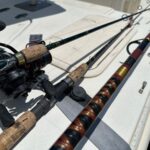When it comes to pursuing and catching truly massive sunfish, few places on earth compare to Lake Havasu.
Nestled on the border between Arizona and California, this man-made reservoir is over 19,000 acres and is one of the top fishing destinations in the country. In these waters, you can find the home of world-class redear sunfish, bluegill, crappie, and even great bass fishing!
If you love BIG sunfish or panfish, and you are in the process of planning a fishing trip to Lake Havasu, then you have come to the right place.
In this article, I will cover everything that you will need to know when fishing at Lake Havasu and help you catch some of its world-famous fish!
Table of Contents
Redear Sunfish
Redear sunfish are one of the most popular and plentiful fish species in Lake Havasu. Anglers from all over the world travel to this lake just to get a chance to catch one of these amazing fish.
Redear sunfish very closely resemble the more popular bluegill except for their coloration and larger size. Their color can range from dark olive-green to near white on the belly, with yellow or green sides and the unmistakable red dot on the side that gives them their name.
These fish most commonly eat snails as their main food source, a habit that gives them the nickname “shell cracker” in other parts of the country.
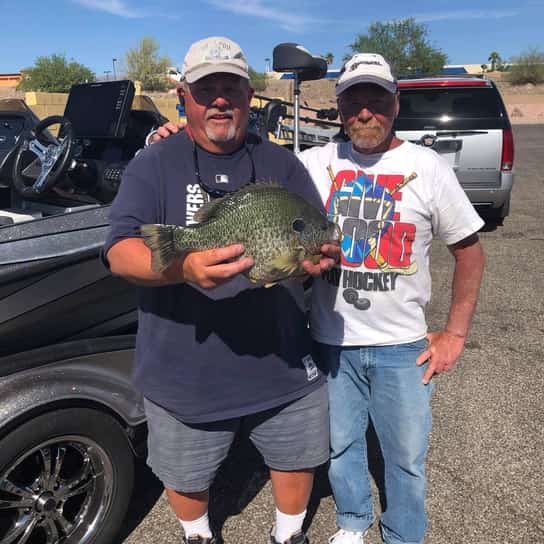
They do, however, eat anything that they can find including insect larvae, baitfish, and other small creatures. They prefer to hang out at the bottom of warm water where they hunt their prey.
Unlike other fish species, redear sunfish do not like to go near the surface in order to eat flies or other top baits. They can however be easily caught using all manner of baits and other artificial lures. Some favorites include natural baits such as grubs and earthworms.
When it comes to artificial lures, crappie jigs and trout spinners can work extremely well (but more on that later).
Where to Find Redear Sunfish on Lake Havasu
So where do you get started when it comes to finding giant sunfish on Lake Havasu? While these fish can be found throughout the entire lake, there are a few places that always seem to produce more than others.
The first places to look on your search for big redear sunfish should include any of the many marinas and structures around the lake. In particular, the Lake Havasu marina can produce good numbers of redear. Another popular destination is Stone Bridge Pier.
Both of these areas will see panfish of all shapes and sizes, but redear are sure to make plenty of appearances.
Another great hotspot for redear sunfish is Catfish Bay. This sheltered bay can really be an amazing spot during high winds or strong water currents.
You will find that this area is made up of reeds on the northern end and shallow, rocky points along the south. Redear can be found along both ends, both in the reeds and along the rocky outcroppings.
Lastly, one of the best locations to find redear sunfish and other sunfish, in general, is from any of the free fishing docks or piers along the lake. These structures attract all types of fish, but sunfish in particular. Some of the hotspots include the fishing docks at:
- Bill Williams National Wildlife Refuge
- Havasu National Wildlife Refuge
- Site Six
- Take Off Point
- Mesquite Bay North and South (two different locations)
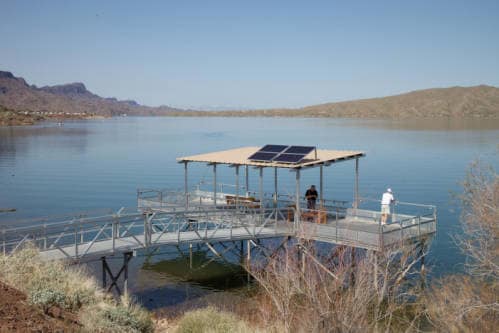
While these areas tend to produce the best numbers and largest sizes of redear sunfish, anywhere in the lake can produce giant sunfish regardless of where you start your search!
Tips to Catch Redear Sunfish
As redear sunfish grow into adults, they will tend to primarily feed on things like snails, mussels, and insects. When given the opportunity, they will also feed on small fish.
With that said, there are still plenty of live and natural bait options that can catch big redear sunfish. Things such as mealworms, nightcrawlers, or crickets will generally produce the best results.
Larger worms should be cut into smaller sections in order to allow sunfish to get them in their small mouths. That being said, don’t be afraid to experiment with larger baits as well.
If you are struggling to get good bites, sometimes offering a bigger worm or other bait can induce some bites. Artificial lures can also be used, but they do not seem to be as effective for sunfish as some natural baits on the end of a hook.
A few popular lures include Berkley’s artificial cricket bait, rubber grubs, Yakima rooster tails, and Gulp minnows.
Regardless of whether you are using live bait or an artificial lure, keep your hooks in size #8 or #10. Long shank hooks tend to work the best, but circle hooks of this size can also be effective.
Paired with some 4 or 6-pound monofilament line, you have a great setup that will be a lot of fun to catch these fish on.
Give the folks at Bass Tackle Master a call, they are the premier bait and tackle shop on the Arizona side of the lake and they’ll be happy to give you some pointers.
Best Time of Year to Target Redear Sunfish on Lake Havasu
Once you have your bait ready and a location picked out, now it’s time to find them in the water. Like most other fish, the best time to catch redear sunfish is during their spawn.
These fish start to spawn in the spring as water temperatures get anywhere from 65 to 70 degrees, but the ideal fishing temperatures you will want to shoot for at Lake Havasu are anywhere from 72 to 75 degrees.
Because the spring and early summer will give you the best results, the ideal months to pursue redear sunfish on Lake Havasu are March, April, and May.
These months will give you the best possible conditions to catch large numbers of fish, although redear can be caught at any time of year here.
Regardless of what time of year you go, there is sure to be great fishing to be had for redear sunfish. In fact, the previous world record was caught during the cold month of February.
This fish weighed 5.8 pounds and was caught in 2014. The new world record redear sunfish is an amazing 6.3 pounder that was caught in May 2021.
Bluegill
Bluegill is another species of sunfish that is very common in Lake Havasu. And just like redears, bluegill here can grow to some enormous sizes. These fish can be identified from other sunfish by the spot at the base of the dorsal fin, bars along their sides, and their smaller mouth.
Their backs and upper sides are generally dark olive green that blends down to brown, orange, or copper on the ides and a yellow or red on the belly.
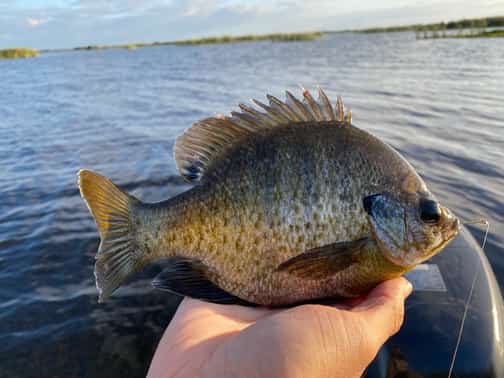
Bluegills are opportunistic feeders that have a wide range of prey. When given the chance, they will feed upon things like insects, small invertebrates, mussels, crayfish, and small baitfish.
But because they have such small mouths, the size of the bluegill will largely determine the type of prey that they can consume.
Where to Find Bluegill on Lake Havasu
When it comes to finding bluegill, you can look in many of the same areas where you will find redear sunfish. These fish prefer areas that have aquatic plants or any other structures (manmade or natural) in order to give them cover, protection, and ambush locations.
They are particularly fond of weed beds, as this gives them plenty of hunting grounds to cover and a place to spawn. In the summer months, larger bluegills will move to deep, open water near the surface where they will feed on plankton and other insects.
So where can you find these types of places on Lake Havasu? Going back to our list of fishing docks that we mentioned before, bluegill can be found and caught from all of them. Both national wildlife refuges (Bill Williams and Havasu) are particularly great for bluegill, as well as Mesquite Bay.
The northern fishing dock at Mesquite Bay can be an excellent location on windy days, as it is sheltered on most sides and has surrounding weed beds for fish to hide in.
Because bluegill love hiding in weed beds, an excellent location to find them is Jops Harbor on the northern end of the lake. This small bay has plenty of surrounding reeds and tulles along with its submerged vegetation and grass during the summer that tends to attract bluegill by the thousands.
Castle Rock Bay, just north of Jops Harbor, can also be excellent and has plenty of weed beds to fish. It is also another great option on windy days as it is one of the most sheltered bays on the entire lake!
Again, remember that bluegill love structure. Here is a map with some of the more popular boat ramps, marinas, and piers that are all sure to hold some bluegill around (as well as redear sunfish).
Tips to Catch Bluegill On Lake Havasu
Catching bluegill is almost exactly the same as catching redear sunfish. Live baits will be your best friend, and a combination of worms, crickets, and mealworms should cover all of your bases.
Just keep in mind that bluegill have even smaller mouths than redears, and generally do not grow as large in size. This means that you must ensure that whatever bait you use is small enough for them to eat.
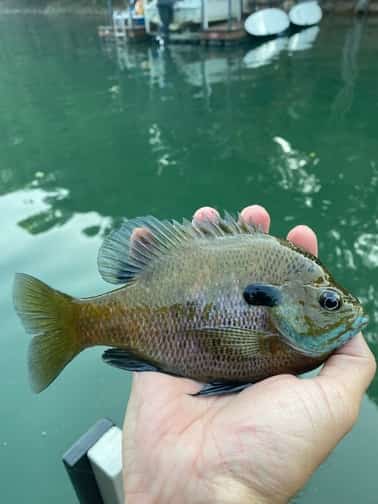
These fish like to hang around depths of 3 to 6 feet on this lake, so they can easily be targeted with a simple bobber setup. Using a simple spring-slip bobber, use a leader of around 12 to 18 inches.
Add a split shot if needed in order to keep the bait suspended in the right place. Bluegill are small fish, so a 2 to 4-pound test monofilament line is sufficient. A clear color is also ideal as it will reduce visibility and Lake Havasu is an extremely clear lake.
You May Also Like: The Top 10 Bluegill Lures Of All Time
In areas with more shallow water, you can also set up near the bottom and find good success. You can utilize this same setup, but instead of a bobber throw on a ½ ounce slip sinker with a swivel or even a small barrel weight in order to get your bait down to the bottom. When fishing the bottoms, stick to shallow water no more than 5 or 6 feet deep.
Best Time of Year to Target Bluegill on Lake Havasu
Because bluegill is one of the easiest fish species to catch with a rod and reel, you can fish for them year-round on Lake Havasu and find plenty of success. If you want to target the spawn, however, you have to come during the spring and summer.
Bluegill will begin to spawn here in late March or April and continue into the summer.
Better weather and fishing temperatures for an angler will be earlier in the spring before it gets too hot, but even during the extreme heat of the summer months bluegill will be very active and be biting!
Crappie
Lake Havasu is also home to a healthy population of black crappie. Crappies are a schooling fish and a favorite amongst anglers for the incredible fight they give and the excellent table fare they provide.
Black crappie, which is the only species found in Lake Havasu, are very similar to white crappie in shape, size, and behavior and can be distinguished by their darker color and pattern of black spots.
Smaller black crappies will feed primarily on plankton and small crustaceans, while larger fish will eat small baitfish (such as shad or minnows), insects, and mussels.
Because of the large population of mussels in Lake Havasu, all of the redear sunfish, bluegill, and crappie do extremely well because of their preferred diets.
Where to Find Crappie on Lake Havasu
Unlike redear sunfish and bluegill, crappie in Lake Havasu prefer more open water and locations that many bass anglers will target. This means you will have to change your strategy if you want to target crappie on this lake, a boat is almost a necessity.
One popular area that can be excellent for crappie is Ski Cove One to Grass Island. Here you will find patches of submerged logs and brush that give crappie places to hide and ambush their prey, and during the summer large sections of grass will grow.
This area is found on the southeast section of the lake, and you will need a boat to access it. While it is more popular as a largemouth bass area, large numbers of crappie can also be found here.
Next on our list of crappie areas is Topock Marsh. There are three different sites that can get you boat access to this area including North Dike, Five Mile Landing, and Catfish Paradise.
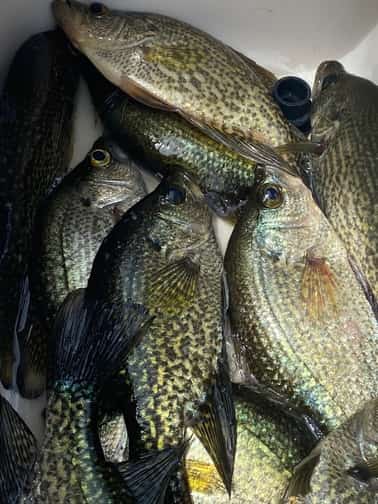
You can also find some decent shore fishing in this area as well. The marsh has plenty of great fish numbers, and schools of crappie can usually be found in this area during the spring.
Last but certainly not least is an area called Windsor Beach. This area covers almost a mile and a half of shoreline and is a great location for redear sunfish, bluegill, and of course, crappie.
This is due to the number of fishing docks, marinas, and artificial structures specially placed to help the fish.
This gives all fish species places to hide and hunt, and you can either fish from the shoreline or bring a boat, canoe or kayak to get further out. Found in the middle portion of the lake, the Windsor beach area is a very popular fishing location.
Tips to Catch Crappie On Lake Havasu
Crappie tend to be more aggressive than redear or bluegill, so artificial lures will work very well for them. Things like twister tail grubs, spinners, small crankbaits, and swimbaits will all work for crappie.
Jig fishing for crappie is a longtime favorite and paired with a 4 to 6-pound test monofilament line this method can be fished in all types of situations.
If all else fails, crappie will also bite on natural baits like worms and crickets as well. Once you figure out what the fish want to bite on, you can usually catch multiple crappie in a single area as they prefer to live in schools of multiple individuals.
Use a size #1, #2, or #4 Eagle Claw hook and try to keep your bait alive as long as possible. Gamakatsu circle hooks can be an excellent choice for live bait as well, just stick to the same #1, #2, or #4 sizes.
Crappies can be caught using a wide variety of different methods and rigs, depending on the bait or lure you want to use. A favorite for Lake Havasu is the simple slip float rig with live minnows, as these fish stay in relatively shallow water and the visibility is excellent.
This rig is made by using something like a Thill Center Slider slip float with a threaded line through it. Tie on an ⅛ ounce jig tipped with a minnow or other bait of choice. Tie on a stop knot above the float and you are ready to fish!
Best Time of Year to Target Crappie on Lake Havasu
Timing the crappie spawn is important if you want to be able to quickly and easily find these fish. This is because crappie will move into the shallows in order to spawn, where they are much more concentrated and easier to catch.
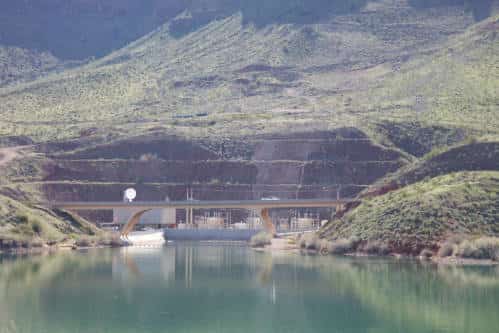
The crappie spawn in Lake Havasu will start at the end of February or March.
By far the best time of year to fish for crappie is the early spring during the spawn, but late fall can be good as well when the temperatures cool off from the hot summer months.
The great thing about Lake Havasu, however, is that the fish (especially crappie) can be successfully caught year-round!
Frequently Asked Questions
Do you need any special licenses or permits in order to fish at Lake Havasu?
No, all you will need is an Arizona state fishing license in order to fish here. For more information on costs, visit the state-by-state fishing license chart.
Does Lake Havasu have its own fishing regulations and/or rules?
Yes, there are currently set bag limits and rules in order to fish at Lake Havasu. The limit of sunfish and crappie for this area is 25 of any combination. For the most up to date, rules and regulations regarding fishing on Lake Havasu, visit https://www.azgfd.com/Fishing/
Are there any places to stay or camp at Lake Havasu?
Yes, there are plenty of surrounding campsites around the lake as well as hotels, cabins, and houseboats that are available to rent.
How hot/cold does the weather get at Lake Havasu?
Depending on the time of year, temperatures at Lake Havasu can vary greatly. During the spring when most fishing is at its best, average highs are in the 60s and 70s. Starting in May and into the summer, highs will get over 100 degrees.
Are there other fish species at Lake Havasu that I can also catch?
Lake Havasu is home to trophy largemouth and smallmouth bass, as well as striped bass, channel catfish, trout, and of course world-famous sunfish.
You May Also Like: Fishing Lake Mead- Tips, Charter Reviews & Species Guide
If you haven’t guessed yet, I love fishing and everything about it!
To learn more about why I started Panfish Nation, visit the About page and follow along on Social Media:


Download a copy of my FREE Lure Color Selection Chart & Knot Guide!
Stay up to date with fishing reports, tackle reviews, industry news, and much more! We respect your privacy, unsubscribe at any time.
- Crazy Facts About the World Record Crappie

- What Size Hooks for Smallmouth Bass? Quick Guide

- Large and in Charge-Mouth: 10 of the Best Bass Lures of All Time (And Where to Buy Them)

- Emperor of the Sun(fish): What You Need to Know About the World Record Bluegill
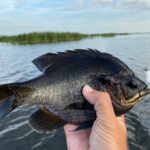
- The Seven Best Lures for Fall Bass Fishing
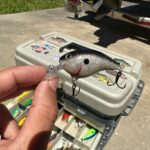
- Which Fishing Line is Best for Bass Fishing With A Spinning Reel?
